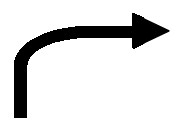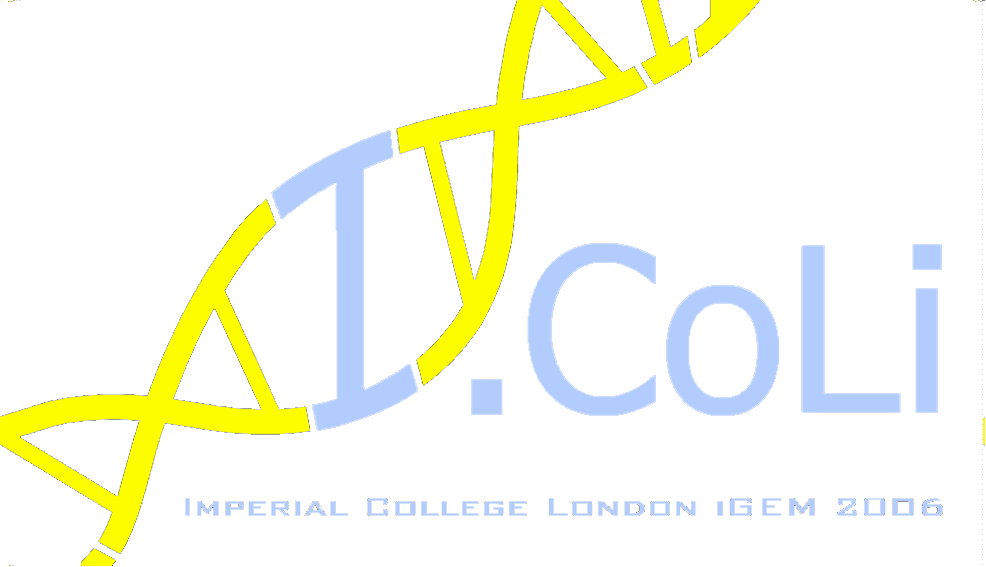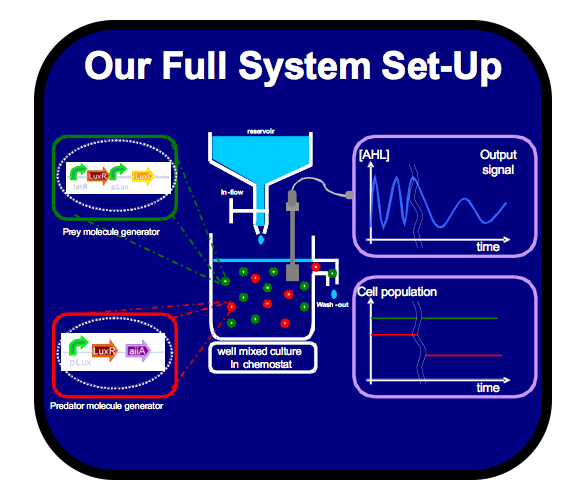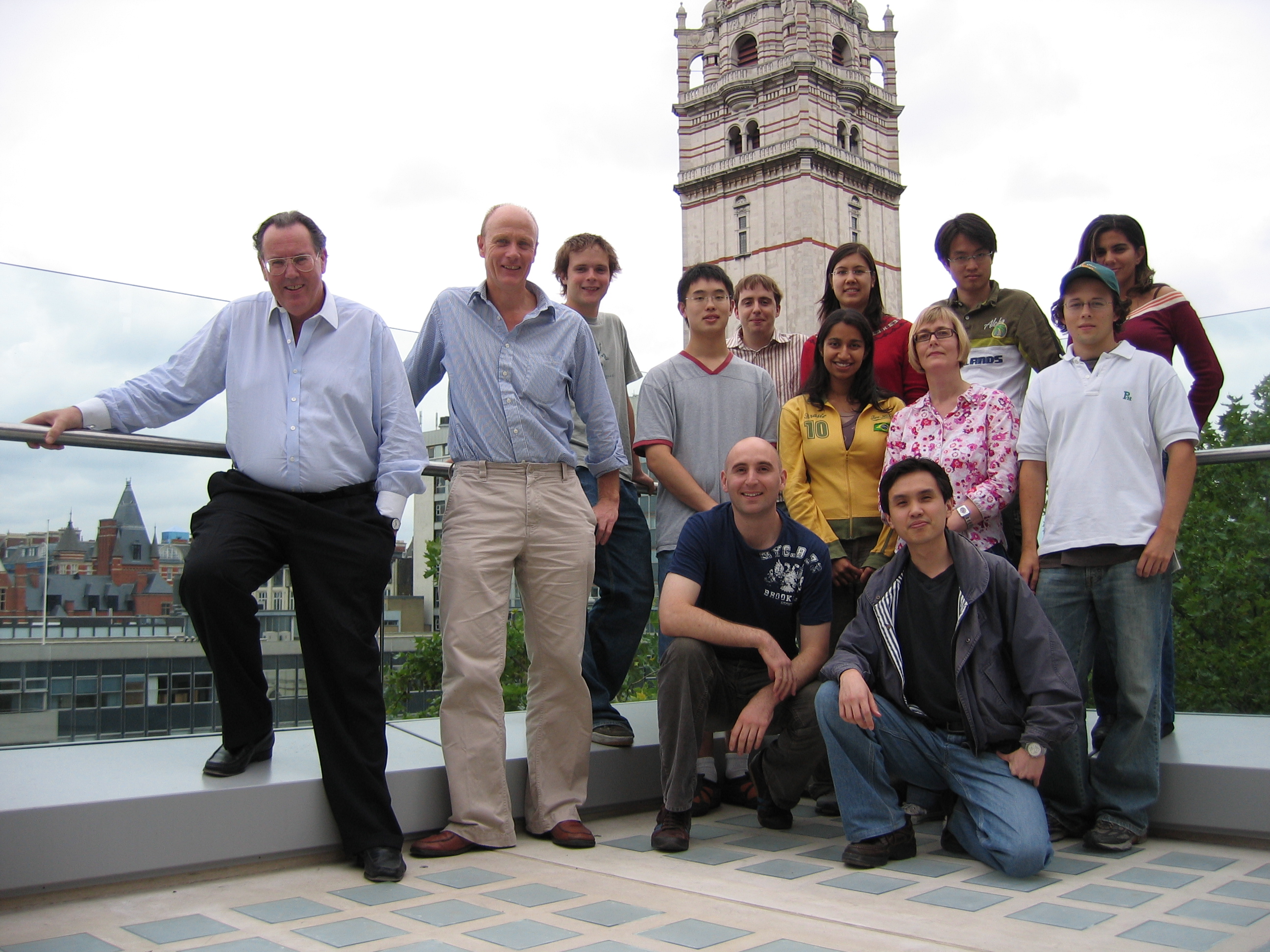Imperial College 2006
From 2006.igem.org
m |
|||
| Line 1: | Line 1: | ||
__NOTOC__ | __NOTOC__ | ||
| - | + | __NOTOC__ | |
| + | <center>{{Click||image=Banner.png|link=IGEM:IMPERIAL/2006|width=800px|height=100px}}</center> | ||
| + | <center><big>'''[http://openwetware.org/wiki/IGEM:IMPERIAL/2006 Full Documentation of the project on OWW]'''</big></center> | ||
| - | |||
| - | [ | + | {| border="0" width="100%" style="padding: 5px; background-color: #ffffff; border: 2px solid #2171B8;" |
| - | + | |- | |
| - | + | |width="20%" style="background:#2171B8"|[[Image:LogoFinal2.png|210px|center]] | |
| - | + | |width="40%" style="background:#2171B8"| <font face="arial" font style="color: #FFFFFF" > <center><big><u>'''Project Summary'''</u></big></center> <br> Oscillators are a fundamental building block in many fields of engineering and are a widespread phenomenon in biology. Building a biological oscillator is thus a critical step forward in the field of Synthetic Biology. <br><br> | |
| - | + | '''Engineering a Molecular Predation Oscillator''', the iGEM project 2006 of Imperial College London, provides a new approach to creating a stable biological oscillator: It follows an engineering-based cycle of specification, design, modelling, implementation and testing/validation. The innovative design of the oscillator relies on predator-prey dynamics based on the Lotka-Volterra model. </font> | |
| - | + | |width="40%" style="background:#2171B8" | <font face="arial" font style="color: #FFFFFF" > <center><big><u>'''Achievements'''</u></big></center> <br> | |
| + | Following the design of the oscillator, a full theoretical analysis and detailed computer modelling of the Lotka-Volterra dynamics was carried out. These studies showed that it is theoretically possible to provide a stable oscillator. Because all components as well as the overall oscillator were modelled, its behaviour could be accurately predicted. Our team successfully built the functional parts, thus providing the building blocks for the final oscillator. All parts created were experimentally tested and their characterization could be used to feedback information into the modelling. | ||
| + | <br> | ||
| + | <br> | ||
| + | <br> | ||
| + | </font> | ||
| + | |} | ||
| - | |||
| - | |||
| - | == | + | ==Main Project== |
| + | {| border="0" width="100%" align="center" style="padding: 5px; background-color: #ffffff; border: 2px solid #2171B8;" | ||
| + | | width="20%" style="background:#2171B8"| <center>[[Image:Oscillator Icon.PNG|100px|center]] </center> | ||
| + | | style="background:#2171B8" colspan="3"| <font face="arial" font style="color: #FFFFFF"> <center><big>'''Engineering a Molecular Predation Oscillator'''</big><br> | ||
| + | For building our biological oscillator, the engineering cycle below was followed.<br> | ||
| + | '''Click on each of the stages of the engineering cycle below in order to find out about the different stages & aspects of the project. '''</center> | ||
| + | |- | ||
| + | | style="background:#2171B8" width="200pt" rowspan="4" | | ||
| + | <font face="arial" font style="color: #FFFFFF"> '''1) Specifications: ''' | ||
| + | *Stable and robust oscillations | ||
| + | *Controllable frequency/amplitude | ||
| + | *Generic and modular | ||
| + | '''2) Design: ''' | ||
| + | *Mimics predator-prey dynamics based on the Lotka-Volterra model | ||
| + | '''3) Modelling: ''' | ||
| + | *Full theoretical analysis [http://www.openwetware.org/wiki/IGEM:IMPERIAL/2006/project/Oscillator/Theoretical_Analyses] | ||
| + | *Modelling of the full system | ||
| + | '''4) Implementation: ''' | ||
| + | *All parts designed | ||
| + | *4 functional & 5 intermediate submitted to the Registry | ||
| + | '''5) Testing/Validation: ''' | ||
| + | *Successful characterization of sub-components.</font> | ||
| + | | align="right"|[[Image:ArrowCurvedRight.png|110px]] | ||
| + | | align="center" |[http://www.openwetware.org/wiki/IGEM:IMPERIAL/2006/project/Oscillator/project_browser/Full_System/Design http://openwetware.org/images/c/ce/IGEM_IMPERIAL_DevCycle_Design.png] | ||
| + | | align="left"|[[Image:ArrowCurvedDown.PNG|120px]] | ||
| + | |- | ||
| + | | align="center"|[http://www.openwetware.org/wiki/IGEM:IMPERIAL/2006/project/Oscillator/project_browser/Full_System http://openwetware.org/images/f/fd/IGEM_IMPERIAL_DevCycle_Specifications.png] | ||
| + | | align="center" rowspan="2"|[[Image:IGEM_IMPERIAL_DevCycle_FullSystem.png |206px|center]] | ||
| + | | align="center"|[http://www.openwetware.org/wiki/IGEM:IMPERIAL/2006/project/Oscillator/project_browser/Full_System/Modelling http://openwetware.org/images/5/5f/IGEM_IMPERIAL_DevCycle_Modelling.png] | ||
| + | |- | ||
| + | | align="center"|[[Image:ArrowUp.png|20px]] | ||
| + | | align="center"|[[Image:ArrowDown.png|20px]] | ||
| + | |- | ||
| + | | align="center"|[http://www.openwetware.org/wiki/IGEM:IMPERIAL/2006/project/Oscillator/project_browser/Full_System/TestingValidation http://openwetware.org/images/2/20/IGEM_IMPERIAL_DevCycle_Validation.png] | ||
| + | | align="center"|[[Image:ArrowLeft.png|150px]] | ||
| + | | align="center"|[http://www.openwetware.org/wiki/IGEM:IMPERIAL/2006/project/Oscillator/project_browser/Full_System/Implementation http://openwetware.org/images/0/04/IGEM_IMPERIAL_DevCycle_Implementation.png] | ||
| + | |} | ||
| - | + | ==Secondary Projects== | |
| + | {| border="0" width="100%" style="padding: 5px; background-color: #ffffff; border: 2px solid #2171B8;" width="100%" | ||
| + | |- | ||
| + | ! width="50%" | <big>'''[http://openwetware.org/wiki/IGEM:IMPERIAL/2006/project/popsblocker <font face="arial" font style="color: #2171B8">PoPs Blocker</font>] '''</big>!! width="50%"| <big>'''[http://openwetware.org/wiki/IGEM:IMPERIAL/2006/project/Bio_elec_interface <font face="arial" font style="color: #2171B8">Biological to Electrical Interface]</font>'''</big> | ||
| + | |- | ||
| + | | style="background:#2171B8" width="50%" | | ||
| + | <font face="arial" font style="color: #FFFFFF"> As a method of controlling the activation of the positive-feedback loop in our predator-prey based oscillator, we successfully created this part, which can be used as a general Pops Blocker: | ||
| + | *This part is placed downstream of a promoter and prevents any Pops from the promoter passing through this part | ||
| + | *When an accompanying Cre Recombinase plasmid becomes activated, the enzyme produced will permanently cut a section of DNA from the plasmid containing this part | ||
| + | *Only then, the polymerase can pass through this part and transcribe downstream genes. | ||
| + | </font> | ||
| + | | style="background:#2171B8" width="50%" | | ||
| + | <font face="arial" font style="color: #FFFFFF">We also worked on a Biosensor for measuring AHL concentrations in order to establish a Biological to Electrical Interface this summer. | ||
| + | *Using an enzyme to hydrolize the lactone AHL would result in a local change in pH | ||
| + | *Measuring the change in pH gives a measurement of how much AHL is present. | ||
| + | <br> | ||
| + | <br> | ||
| + | <br> | ||
| + | <br> | ||
| + | </font> | ||
| + | |} | ||
| - | [[Image: | + | ==Our Contributions to the Registry== |
| + | {|border="0" width="100%" style="padding: 5px; background-color: #ffffff; border: 2px solid #2171B8;" | ||
| + | ! style="background:#2171B8" | <font face="arial" font style="color: #FFFFFF">Part Logo !! style="background:#2171B8" |<font face="arial" font style="color: #FFFFFF">Description</font> !! style="background:#2171B8" |<font face="arial" font style="color: #FFFFFF">Link to registry</font> !! style="background:#2171B8" |<font face="century gothic" font style="color: #FFFFFF">Built</font> !! style="background:#2171B8" |<font face="arial" font style="color: #FFFFFF">Tested </font>!! style="background:#2171B8" |<font face="arial" font style="color: #FFFFFF">Characterized </font>!! style="background:#2171B8" |<font face="arial" font style="color: #FFFFFF">Sequenced</font> !! style="background:#2171B8" |<font face="arial" font style="color: #FFFFFF">Sent</font> | ||
| + | |- | ||
| + | !style="background:#008080" |<font face="arial" font style="color: #FFFFFF">Final Constructs</font> | ||
| + | !style="background:#008080"| | ||
| + | !style="background:#008080"| | ||
| + | !style="background:#008080"| | ||
| + | !style="background:#008080"| | ||
| + | !style="background:#008080"| | ||
| + | !style="background:#008080"| | ||
| + | !style="background:#008080"| | ||
| + | |- | ||
| + | ![[Image:J37015.PNG|250px]]!! Final Prey Cell !! <bbpart>J37015</bbpart> !! YES !! YES !! Pending !! YES !! YES | ||
| + | |- | ||
| + | ! [[Image:J37027.png|120px]] !! Cre/Lox Prey Control !! <bbpart>J37027</bbpart> !! YES !! YES !! YES !! YES !!YES | ||
| + | |- | ||
| + | !style="background:#008080" |<font face="arial" font style="color: #FFFFFF">Test Constructs</font> | ||
| + | !style="background:#008080"| | ||
| + | !style="background:#008080"| | ||
| + | !style="background:#008080"| | ||
| + | !style="background:#008080"| | ||
| + | !style="background:#008080"| | ||
| + | !style="background:#008080"| | ||
| + | !style="background:#008080"| | ||
| + | |- | ||
| + | ![[Image:J37016.PNG|150px]]!! Final Polycistronic Predator Cell Test Construct !! <bbpart>J37016</bbpart> !! YES !! YES !! YES !! YES!! YES | ||
| + | |- | ||
| + | ! [[Image:J37020.png|170px]] !! Predator Cell, pLux Transfer Function (two promoters) !! <bbpart>J37020</bbpart> !! YES !! YES !! NO !! NO !! YES | ||
| + | |- | ||
| + | !style="background:#008080" |<font face="arial" font style="color: #FFFFFF">Intermediate Parts</font> | ||
| + | !style="background:#008080"| | ||
| + | !style="background:#008080"| | ||
| + | !style="background:#008080"| | ||
| + | !style="background:#008080"| | ||
| + | !style="background:#008080"| | ||
| + | !style="background:#008080"| | ||
| + | !style="background:#008080"| | ||
| + | |- | ||
| + | ! [[Image:J37019.PNG|80px]] !! AHL induced LuxR generator (for predator cell) !! <bbpart>J37019</bbpart> !! YES !! N/A !! N/A!! YES !!YES | ||
| + | |- | ||
| + | ! [[Image:J37033.PNG|65px]] !! RBS + LuxR !! <bbpart>J37033</bbpart> !! YES !! N/A !! N/A!! YES !!YES | ||
| + | |- | ||
| + | ! [[Image:J37034.PNG|90px]] !! Prey Cell Intermediate!! <bbpart>J37034</bbpart> !! YES !! N/A !! N/A!! YES !!YES | ||
| + | |- | ||
| + | ! [[Image:J37032.png|90px]] !! LuxR + GFP !! <bbpart>J37032</bbpart> !! YES !! N/A !! N/A!! YES !!YES | ||
| + | |} | ||
| - | == | + | ==Our Open Documentation== |
| - | + | *Full Documentation, 100's of Photographs, Extensive Modelling, Lab Notebook and much more! | |
| - | === | + | __NOTOC__ |
| + | {| class="wikitable" border="0" cellpadding="10" cellspacing="1" style="padding: 5px; background-color: #ffffff; border: 2px solid #2171B8;text-align:center" | ||
| + | !width="20%" align="left" valign="top" style="background:#2171B8; color:black"| | ||
| + | *[http://openwetware.org/wiki/IGEM:IMPERIAL/2006/LabCalendar <font face="arial" font style="color: #FFFFFF">Lab Notebook</font>] | ||
| + | *[http://openwetware.org/wiki/IGEM:IMPERIAL/2006/Protocols <font face="arial" font style="color: #FFFFFF">Protocols</font>] | ||
| - | *< | + | !width="20%" align="left" valign="top" style="background:#2171B8; color:black"| |
| - | * | + | *[http://openwetware.org/wiki/IGEM:IMPERIAL/2006/Journal_Club<font face="arial" font style="color: #FFFFFF"> Journal Club</font>]<br\> |
| - | + | *[http://openwetware.org/wiki/IGEM:IMPERIAL/2006/Lecture_Notes <font face="arial" font style="color: #FFFFFF">Lecture Notes</font>]<br\> | |
| - | + | ||
| - | [ | + | !width="20%" align="left" valign="top" style="background:#2171B8; color:black"| |
| + | *[http://openwetware.org/wiki/BioSysBio:abstracts/2007/iGEM2006_Imperial_College <font face="arial" font style="color: #FFFFFF">BioSysBio Conference, UK</font>] | ||
| - | *< | + | !width="20%" align="left" valign="top" style="background:#2171B8; color:black"| |
| - | + | *[http://openwetware.org/wiki/IGEM:IMPERIAL/2006/Calendar/2006-7-26 <font face="arial" font style="color: #FFFFFF">UK iGEM Teams Meeting</font>] | |
| - | + | ||
| - | + | ||
| - | + | ||
| - | + | ||
| - | + | ||
| - | [ | + | !width="20%" align="left" valign="top" style="background:#2171B8; color:black"| |
| + | *[http://openwetware.org/wiki/IGEM:IMPERIAL/2006/Photos <font face="arial" font style="color: #FFFFFF">Photos</font>] | ||
| + | |} | ||
| - | + | ==The Team and Acknowledgements== | |
| - | + | ||
| - | + | ||
| - | + | ||
| - | + | ||
| - | + | ||
| - | + | ||
| - | + | ||
| - | + | {| class="wikitable" border="0" width="100%" cellpadding="10" cellspacing="1" style="padding: 5px; background-color: #ffffff; border: 2px solid #2171B8;text-align:center" | |
| + | !width="20%" align="left" valign="top" style="background:#2171B8; color:black"| | ||
| + | <center> | ||
| - | === | + | ==<font face="arial" font style="color: #FFFFFF">Undergrads</font>== |
| + | </center> | ||
| + | *[http://openwetware.org/wiki/User:Cys <font face="arial" font style="color: #FFFFFF">Christin Sander</font>] | ||
| + | *[http://openwetware.org/wiki/User:da104 <font face="arial" font style="color: #FFFFFF">Deepti Aswani</font>] | ||
| + | *[http://openwetware.org/wiki/User:Farah <font face="arial" font style="color: #FFFFFF">Farah Vohra</font>] | ||
| + | *[http://openwetware.org/wiki/User:Baijiongjun<font face="arial" font style="color: #FFFFFF"> Jiongjun Bai</font>] | ||
| + | *[http://openwetware.org/wiki/User:Johnsy <font face="arial" font style="color: #FFFFFF">John Sy</font>] | ||
| + | *[http://openwetware.org/wiki/User:JohnChattaway <font face="arial" font style="color: #FFFFFF">John Chattaway</font>] | ||
| + | *[http://openwetware.org/wiki/User:Jonny<font face="arial" font style="color: #FFFFFF"> Jonathan Wells</font>] | ||
| + | *[http://openwetware.org/wiki/User:Tom <font face="arial" font style="color: #FFFFFF">Tom Hinson</font>] | ||
| - | + | !width="25%" align="left" valign="top" color:black"| | |
| - | + | ||
| - | + | ||
| - | + | ||
| - | + | ||
| - | [[Image: | + | [[Image:IGEM GroupPhotos0015.JPG|thumb|center|200px|The Imperial College iGEM team and advisors on the terrace of the Biochemistry building]] |
| - | + | !width="20%" align="left" valign="top" style="background:#2171B8; color:black"| | |
| - | + | <center> | |
| - | + | ||
| - | + | ||
| - | + | ||
| - | + | ||
| - | [[ | + | ==<font face="arial" font style="color: #FFFFFF">Advisors</font>== |
| + | </center> | ||
| + | *[http://www3.imperial.ac.uk/people/r.kitney <font face="arial" font style="color: #FFFFFF">Prof. Richard Kitney</font>] | ||
| + | *[http://www3.imperial.ac.uk/people/p.freemont <font face="arial" font style="color: #FFFFFF">Prof. Paul Freemont</font>] | ||
| + | *[http://www3.imperial.ac.uk/people/d.mann <font face="arial" font style="color: #FFFFFF">Dr. David Mann</font>] | ||
| + | *<font face="arial" font style="color: #FFFFFF">Kirsten Jensen</font> | ||
| + | *[http://openwetware.org/wiki/User:Vincent <font face="arial" font style="color: #FFFFFF">Vincent Rouilly</font>] | ||
| + | *[http://openwetware.org/wiki/User:chuehloo <font face="arial" font style="color: #FFFFFF">Chueh-Loo Poh</font>] | ||
| + | *[http://openwetware.org/wiki/User:SxE00 <font face="arial" font style="color: #FFFFFF">Matthieu Bultelle</font>] | ||
| - | + | !width="20%" align="left" valign="top" style="background:#2171B8; color:white"| | |
| - | + | ||
| - | + | ||
| - | + | ||
| - | + | <center> | |
| - | === | + | ==<font face="arial" font style="color: #FFFFFF">Funding</font>== |
| - | + | </center> | |
| - | + | *European Commission | |
| - | + | *Imperial College Deputy Rector's Fund | |
| - | + | *Imperial College Faculty of Engineering | |
| - | + | *Imperial College Faculty of Natural Sciences | |
| - | + | |} | |
| - | + | ||
| - | + | ||
| - | + | ||
| - | + | ||
| - | + | ||
| - | + | ||
| - | + | ||
| - | + | ||
| - | * | + | |
| - | + | ||
| - | + | ||
| - | + | ||
| - | + | ||
| - | + | ||
| - | + | ||
| - | + | ||
| - | + | ||
| - | + | ||
| - | + | ||
| - | + | ||
| - | + | ||
| - | + | ||
| - | + | ||
| - | + | ||
| - | + | ||
| - | + | ||
| - | + | ||
| - | + | ||
| - | + | ||
| - | + | ||
| - | + | ||
| - | + | ||
| - | + | ||
| - | + | ||
| - | + | ||
| - | + | ||
| - | + | ||
| - | + | ||
| - | + | ||
| - | + | ||
| - | + | ||
| - | + | ||
| - | + | ||
| - | + | ||
| - | + | ||
| - | + | ||
| - | + | ||
| - | + | ||
| - | + | ||
| - | + | ||
| - | + | ||
| - | + | ||
| - | + | ||
| - | + | ||
| - | + | ||
| - | + | ||
| - | + | ||
| - | + | ||
| - | + | ||
| - | + | ||
| - | + | ||
| - | + | ||
| - | + | ||
| - | + | ||
| - | + | ||
| - | + | ||
| - | + | ||
| - | + | ||
| - | + | ||
| - | + | ||
| - | + | ||
| - | + | ||
<html> | <html> | ||
Revision as of 13:15, 30 October 2006
| Oscillators are a fundamental building block in many fields of engineering and are a widespread phenomenon in biology. Building a biological oscillator is thus a critical step forward in the field of Synthetic Biology. Engineering a Molecular Predation Oscillator, the iGEM project 2006 of Imperial College London, provides a new approach to creating a stable biological oscillator: It follows an engineering-based cycle of specification, design, modelling, implementation and testing/validation. The innovative design of the oscillator relies on predator-prey dynamics based on the Lotka-Volterra model. | Following the design of the oscillator, a full theoretical analysis and detailed computer modelling of the Lotka-Volterra dynamics was carried out. These studies showed that it is theoretically possible to provide a stable oscillator. Because all components as well as the overall oscillator were modelled, its behaviour could be accurately predicted. Our team successfully built the functional parts, thus providing the building blocks for the final oscillator. All parts created were experimentally tested and their characterization could be used to feedback information into the modelling.
|
Main Project
| | For building our biological oscillator, the engineering cycle below was followed. | ||
|
1) Specifications:
2) Design:
3) Modelling:
4) Implementation:
5) Testing/Validation:
| 
| http://openwetware.org/images/c/ce/IGEM_IMPERIAL_DevCycle_Design.png | 
|
| http://openwetware.org/images/f/fd/IGEM_IMPERIAL_DevCycle_Specifications.png | http://openwetware.org/images/5/5f/IGEM_IMPERIAL_DevCycle_Modelling.png | ||
| http://openwetware.org/images/2/20/IGEM_IMPERIAL_DevCycle_Validation.png | http://openwetware.org/images/0/04/IGEM_IMPERIAL_DevCycle_Implementation.png | ||
Secondary Projects
| PoPs Blocker | Biological to Electrical Interface |
|---|---|
|
As a method of controlling the activation of the positive-feedback loop in our predator-prey based oscillator, we successfully created this part, which can be used as a general Pops Blocker:
|
We also worked on a Biosensor for measuring AHL concentrations in order to establish a Biological to Electrical Interface this summer.
|
Our Contributions to the Registry
| Part Logo | Description | Link to registry | Built | Tested | Characterized | Sequenced | Sent |
|---|---|---|---|---|---|---|---|
| Final Constructs | |||||||
| Final Prey Cell | J37015 | YES | YES | Pending | YES | YES | |
| | Cre/Lox Prey Control | J37027 | YES | YES | YES | YES | YES |
| Test Constructs | |||||||
| Final Polycistronic Predator Cell Test Construct | J37016 | YES | YES | YES | YES | YES | |
| | Predator Cell, pLux Transfer Function (two promoters) | J37020 | YES | YES | NO | NO | YES |
| Intermediate Parts | |||||||
| | AHL induced LuxR generator (for predator cell) | J37019 | YES | N/A | N/A | YES | YES |
| | RBS + LuxR | J37033 | YES | N/A | N/A | YES | YES |
| | Prey Cell Intermediate | J37034 | YES | N/A | N/A | YES | YES |
| | LuxR + GFP | J37032 | YES | N/A | N/A | YES | YES |
Our Open Documentation
- Full Documentation, 100's of Photographs, Extensive Modelling, Lab Notebook and much more!
The Team and Acknowledgements
Undergrads |
Advisors |
Funding
|
|---|



